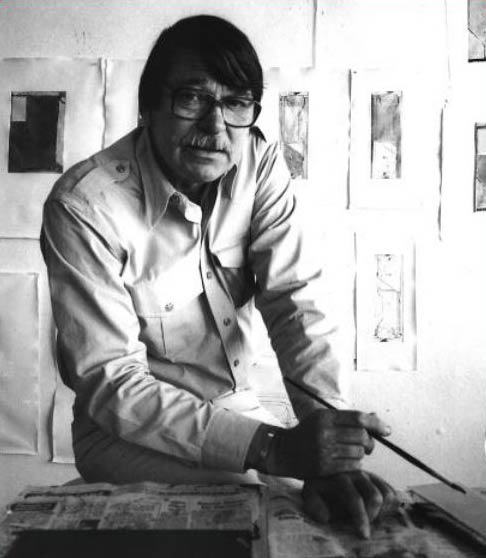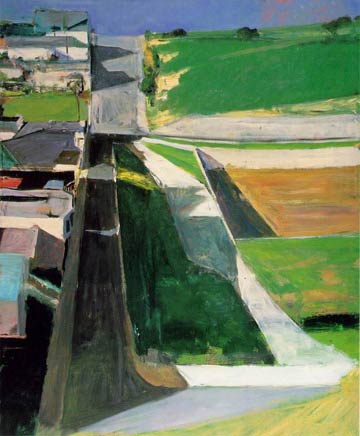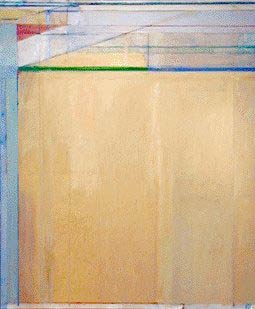| Richard Diebenkorn | |
|---|---|
 |
|
| Born | Apr. 22, 1922 Portland, Oregon |
| Died | Mar. 30, 1993 (at age 70) Berkeley, California |
| Nationality | American |
| Movement | Bay Area Figurative Movement, Abstract Expressionism, Color Field painting, Lyrical Abstraction |
| Field | Painting |
| Works | View Complete Works |
Richard Diebenkorn (1922-1993) was born on April 22, 1922 in Portland, OR. Over the course of his lifetime, he would become a very successful painter on the American art scene. He was a popular artist that made a name for himself in the abstract art movement and then later gained further notoriety when he entered a new phase of his career by becoming part of the Bay Area Figurative Movement in California.
Early Life and Education
At the age of five, Diebenkorn started to draw and showed promise even at a very early age. When he reached adulthood, he enrolled in Stanford University where he would met very influential professors, Victor Arnautoff and Daniel Mendelowitz, both of whom would guide him towards becoming a skilled artist. Richard Diebenkorn started out learning the basics of oil painting, which set the stage for learning the foundational  skills required to be a skilled professional artist.
skills required to be a skilled professional artist.
In the late 1940s/early 1950s, Diebenkorn moved all around the United States working as an artist. While living in New York, he would be introduced to abstract expressionism and this movement would become incredibly influential on his own personal style. In fact, he would go on to join the movement and become a very well-known artist in its circles.
The Abstract Expressionism Period
 Abstract expressionism emerged out of the New York City scene, and it was an extension of European surrealism. Abstract expressionism took surrealism to the next level because, while surrealism at least presented some coherent imagery, abstract art was pure chaos. This chaos reflected raw emotions combined with an anti-authoritarian anger that helped establish the then modern American artists creating abstract works as true visionaries of their time.
Abstract expressionism emerged out of the New York City scene, and it was an extension of European surrealism. Abstract expressionism took surrealism to the next level because, while surrealism at least presented some coherent imagery, abstract art was pure chaos. This chaos reflected raw emotions combined with an anti-authoritarian anger that helped establish the then modern American artists creating abstract works as true visionaries of their time.
Diebenkorn and the West Coast Scene
While Diebenkorn learned and developed his abstract style in New York, he would eventually become known as a West Coast artist. When he moved back to California in 1955, he became one of the most acclaimed of the West Coast abstract artists. He would use his canvas as a means of creating brilliant forms of chaotic self-expression.
 A veteran, Diebenkorn would go on to take advantage of the G.I. Bill and go on to enroll in the University of New Mexico’s graduate fine-arts department. During his tenure at the university, he would create his own form of abstract painting known as lucid abstract expressionism.
A veteran, Diebenkorn would go on to take advantage of the G.I. Bill and go on to enroll in the University of New Mexico’s graduate fine-arts department. During his tenure at the university, he would create his own form of abstract painting known as lucid abstract expressionism.
He returned to California and settled in Berkeley. He would take part in many well publicized travels to Europe where he would both promote his work and improve upon it. Eventually, he would come back to the Bay Area in California where he would remain a fixture on the arts scene.
Works such as Cityscape and Ocean Park would be among his most well-known works. These works would capture the scenery of the many environments in which he lived. Many of the works reflected aerial landscape views of the world. These paintings marked his departure from abstract expressionism as he started to delve into figuration styles.
Final Years
On March 30, 1993, Richard Diebenkorn passed away due to complications related to emphysema. His legacy leaves a significant body of influential work.